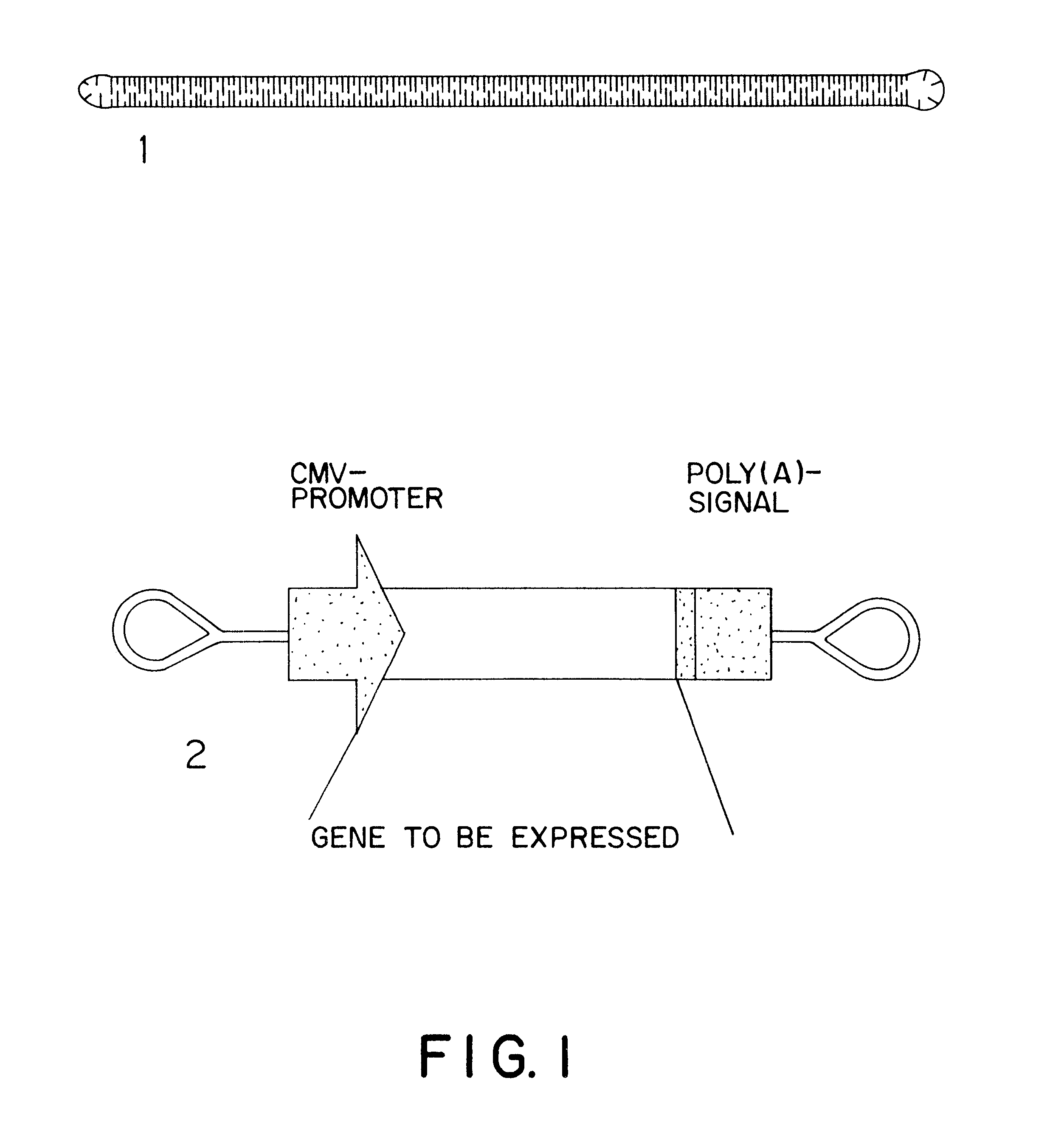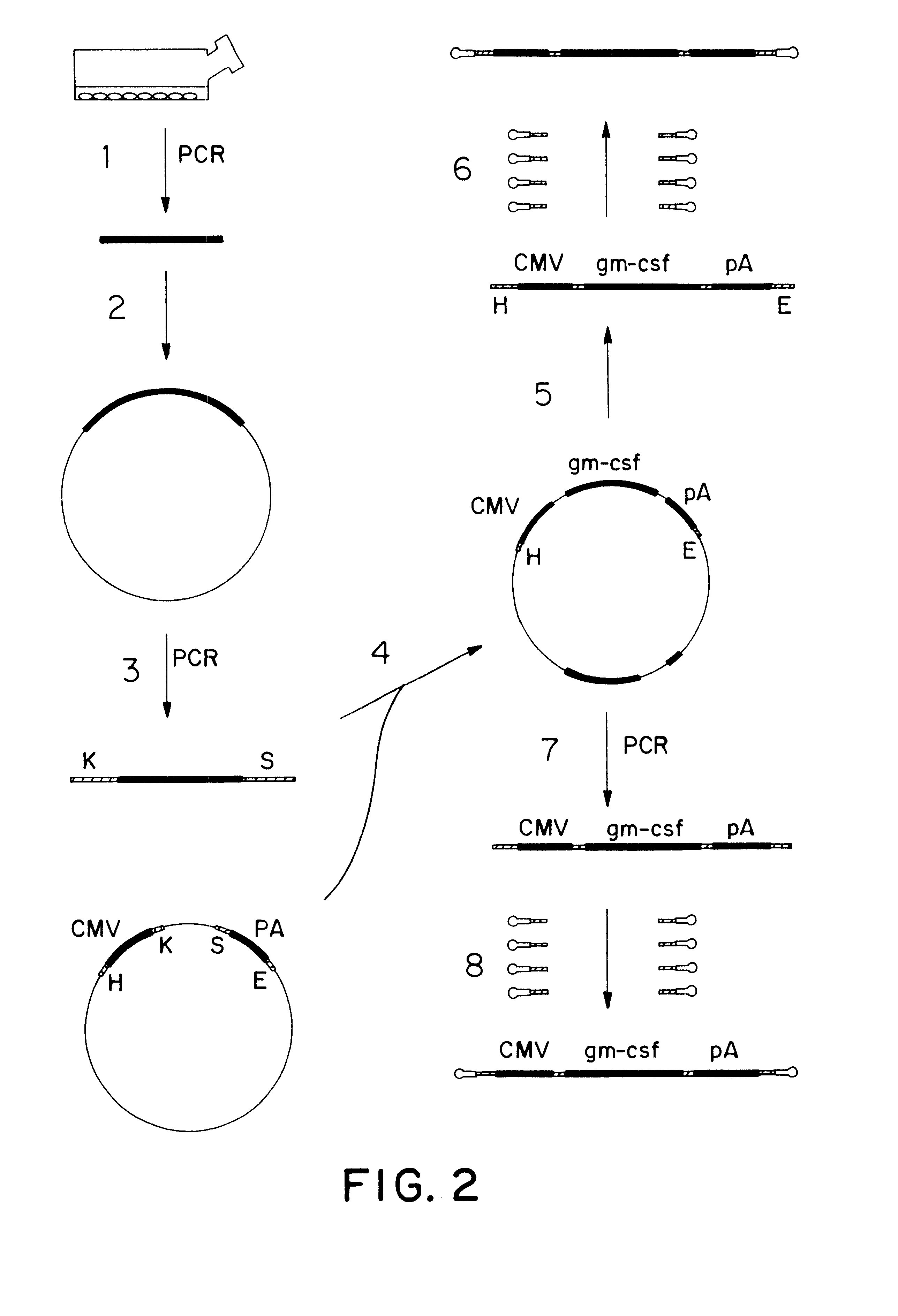Design principle for construction of expression constructs for gene therapy
a gene therapy and construction principle technology, applied in the direction of sugar derivatives, biocide, plant growth regulators, etc., can solve the problems of insufficient sequences for the intended use, inhibiting the fast transport into the cell nucleus, and low efficiency
- Summary
- Abstract
- Description
- Claims
- Application Information
AI Technical Summary
Benefits of technology
Problems solved by technology
Method used
Image
Examples
example 2
[In vivo Expression]
Ballistic Transfer of GM-CSF into K562
30 .mu.l of a suspension of gold particles (1.6 .mu.m diameter, supplied by Bio-Rad, Hercules, Calif., USA, concentration of the suspension: 30 mg / ml) are transferred to a macro carrier-polymer sheet (Bio-Rad). The gold is allowed to sediment, and the supernatant is cautiously removed. Onto the wetted surface, 30 .mu.l of a 1+3 mixture of a suspension of colloidal magnetic particles (mean diameter 65 nm; Miltenyi GmbH, Bergisch-Gladbach, Germany; used as supplied; concentration unknown) and GM-CSF-expression-dumbbell-construct (example 1) are pipetted. The sedimented gold is re-suspended in said mixture and allowed to re-sediment. The supernatant liquid is removed and the gold particles are allowed to dry. 300 .mu.l polylysine are transferred to the center of a petri-dish (3.5 cm), allowed to rest for 30 min and washed off with PBS-medium. 100,000-200,000 cells (erytroleukemia cell line K562) are transferred onto the polylysi...
example 3
[Example for Synthesis of a Expression-construct with Nuclear Localization Sequence]
An expression construct consisting of the gene for a green fluorescent protein under control of the early immediate promoter from CMV and the polyadenylation sequence of SV40 (pEGFP, Clontech Inc.) was obtained by restricition enzyme digestion with EcoRI and HindIII. The smaller fragment was isolated by anion exchange chromatography (stat.phase: Merck Fractogel EMD-DMAE; 25 mM Tris / HCl pH 8; 0-1M NaCl) and ligated after concentration and desalting with a 200-fold molar excess of 5'-phosphorylated hairpin-desoxyoligoribonucleotides AATTCGGCCGGCCGTXTCGGCCGGCCG (SEQ ID NO: 6) and AGCTTGGCCGGCCGTXTCGGCCGGCCA (SEQ ID NO: 7) in the presence of 25 u / ml T4-DNA-Ligase overnight at room temperature (X signifies the peptide modification: Amino-Uracil coupled to the peptide by amide function (TIB-Molbiol, Berlin)) The reaction was stopped by heating to 60.degree. C. The construct ligated to the amino-desoxy-urac...
example 4
[Synthesis of Nucleic-acid-modified Gold Particles]
An expression construct, which consists of the sequence for gm-csf under control of the "early immediate promoter" from CMV and the polyadenylation sequence from SV40 was excised from the plasmid mtv-gmcsf by complete digest with EcoRI and HindIII. The smaller fragment (1290 bp) was isolated by anion exchange chromatography (stat. phase: Merck Fractogel EMD-DMAE; 25 mM Tris / HCl pH 8; 0-1 M NaCl) and following concentration and desalting ligated to a 200-fold molar excess of 5'phosphorylated hairpin desoxyoligoribonucleotides AATTCGGCCGGCCGTXTCGGCCGGCCG (SEQ ID NO:6) and AGCTTGGCCGGCCGTXTCGGCCGGCCA (SEQ ID NO:7) (X specifies the thiol modifier C6 S--S (TIB-Molbiol, Berlin)) in the presence of 25 u / ml T4 DNA Ligase and incubated over night at room temperature. The reaction was stopped by heating to 60.degree. C. The construct ligated to the thiol desoxyribonucleotide was separated from excess thiol modified desoxyribonucleotide by ani...
PUM
| Property | Measurement | Unit |
|---|---|---|
| size | aaaaa | aaaaa |
| size | aaaaa | aaaaa |
| diameter | aaaaa | aaaaa |
Abstract
Description
Claims
Application Information
 Login to View More
Login to View More - R&D
- Intellectual Property
- Life Sciences
- Materials
- Tech Scout
- Unparalleled Data Quality
- Higher Quality Content
- 60% Fewer Hallucinations
Browse by: Latest US Patents, China's latest patents, Technical Efficacy Thesaurus, Application Domain, Technology Topic, Popular Technical Reports.
© 2025 PatSnap. All rights reserved.Legal|Privacy policy|Modern Slavery Act Transparency Statement|Sitemap|About US| Contact US: help@patsnap.com


